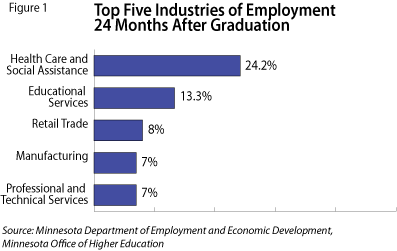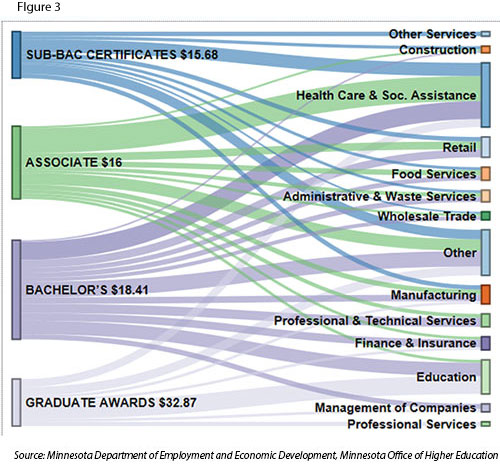
By Alessia Leibert
September 2014
DEED's new Graduate Employment Outcomes tool is providing valuable guidance to students who want to learn which fields offer the best pay and job opportunities.
We've all heard stories about recent graduates who can't find work in their fields of study, so they take jobs as retail clerks or food preparation workers. Could those situations have been avoided if the students had access to information on the employment outcomes of past graduates in their fields?
Fortunately, that information is now available through DEED's new Graduate Employment Outcomes tool. Specifically, the tool shows employment success and wages of past graduates by program of study and indicates which programs offer students the best chances of landing a job in their fields. The information was compiled by linking data on people completing post-secondary awards in Minnesota with employment records following graduation. The data currently available are for those graduating in Minnesota between 2009 and 2011.1
This article focuses on the link between program of study and industry of employment. This link is important because earnings depend not only on the discipline of study but also on the industry where graduates find work. There are two reasons for this. First, some industries simply pay better and offer more opportunities to those with post-secondary credentials than others. Second, if graduates can work in their fields of study, they are more likely to advance in their careers by putting their academic backgrounds to work.
The Graduate Employment Outcomes tool displays the top five industries of employment by major and median wages earned in each industry. The analysis provided here is pulled directly from the Graduate Employment Outcomes tool.
Figure 1 shows the top five industries of employment two years after graduation. One out of four graduates (24 percent) was employed in health care and social assistance, followed by education at 13 percent. These industries continued to grow during the Great Recession and provided more entry-level job opportunities than other sectors, drawing students from a wide variety of majors.
Industry of employment varies over time as people switch jobs. We see a better fit 24 months after graduation than 12 months after. That's because the first job choice after college is often dictated by the need to get back into the workforce and pay bills. Over time, people tend to move into industries that are better aligned with their academic backgrounds.

Figure 2 shows the top industries of employment 24 months after graduation for 35 majors.
Overall, this table shows that there is a good match between educational choices and the top industry of employment. For example, it makes perfect sense for law enforcement graduates to be found in public administration and for physical science graduates to be found in professional and technical services. However, some low wages, especially in retail or in health care and social assistance, reflect an inability to find full-time work or work appropriate to the education level.
| Major | Top Industry of Employment Two Years After Graduation | Hourly Wages Earned by Graduates in the Industry | Types of Businesses Found in the Industry |
|---|---|---|---|
| Agriculture, Agriculture Operations and Related Sciences | Wholesale Trade (18%) | $17.16 | Farm Product Wholesalers |
| Architecture and Related Services | Professional and Technical Services (29%) | $20.19 | Architectural Services |
| Area, Ethnic, Cultural, Gender and Group Studies | Educational Services (23%) | $18.24 | Colleges and Universities |
| Biological and Biomedical Sciences | Health Care and Social Assistance (33%) | $16.22 | Hospitals, Residential Mental Health Facilities |
| Business, Management, Marketing and Related Services | Finance and Insurance (15%) | $22.21 | Banks, Insurance companies |
| Communication, Journalism and Related Programs | Professional and Technical Services (15%) | $18.47 | Advertising firms |
| Communications Technologies/Technicians | Retail Trade (18%) | $10.07 | Electronics and Appliance Stores |
| Computer and Information Sciences | Professional and Technical Services (21%) | $24.67 | Computer Systems Design Services |
| Construction Trades | Construction (43%) | $19.09 | Building Equipment and Finishing Contractors |
| Education | Educational Services (80%) | $30.10 | Elementary and Secondary Schools |
| Engineering | Manufacturing (39%) | $30.44 | Electronic Instrument Manufacturing, Machinery Manufacturing |
| Engineering Technologies and Engineering-Related Fields | Manufacturing (35%) | $21.10 | Machinery Manufacturing |
| English Language and Literature/Letters | Educational Services (23%) | $18.87 | Elementary and Secondary Schools |
| Family and Consumer Sciences/Human Sciences | Health Care and Social Assistance (42%) | $13.06 | Child Day Care Services |
| Foreign Languages, Literatures and Linguistics | Educational Services (23%) | $21.28 | Elementary and Secondary Schools |
| Health Professions and Related Programs | Health Care and Social Assistance (73%) | $21.31 | Hospitals, Residential Care Facilities |
| History | Educational Services (18%) | $18.00 | Colleges and Universities |
| Homeland Security, Law Enforcement, Firefighting and Related Protective Services | Public Administration (35%) | $20.95 | Government, Corrections and Fire Protection |
| Legal Professions and Studies | Professional and Technical Services (39%) | $24.41 | Legal Services |
| Liberal Arts and Sciences, General Studies and Humanities | Health Care and Social Assistance (25%) | $13.83 | Residential Mental Health Facilities, Nursing Care Facilities, Hospitals |
| Mathematics and Statistics | Finance and Insurance (22%) | $26.55 | Insurance Agencies, Financial Investment Firms |
| Mechanic and Repair Technologies/Technicians | Retail Trade (22%) | $13.64 | Automobile Dealers, Auto Parts and Tire Stores |
| Multi/Interdisciplinary Studies | Health Care and Social Assistance (25%) | $17.38 | Residential Mental Health Facilities, Hospitals; Family Services |
| Natural Resources and Conservation | Public Administration (15%) | $15.96 | Administration of Environmental Programs |
| Parks, Recreation, Leisure and Fitness Studies | Health Care and Social Assistance (22%) | $15.60 | Hospitals, Offices of Physicians |
| Personal and Culinary Services | Other Services, Except Public Administration (41%) | $11.87 | Hair, Nail and Skin Care Services |
| Philosophy and Religious Studies | Educational Services (20%) | $16.96 | Elementary and Secondary Schools |
| Physical Sciences | Professional and Technical Services (18%) | $18.68 | Architectural and Engineering Services |
| Precision Production | Manufacturing (53%) | $18.17 | Machine Shops, Metal Manufacturing |
| Psychology | Health Care and Social Assistance (42%) | $15.64 | Mental Retardation Facilities, Family Counseling and Social Service Agencies |
| Public Administration and Social Service Professions | Health Care and Social Assistance (50%) | $18.05 | Family Counseling and Social Service Agencies, Mental and Substance Abuse Care |
| Social Sciences | Health Care and Social Assistance (11%)
Educational Services (11%) |
$14.34 and $16.94 | Family Counseling and Social Service Agencies,
Elementary and Secondary Schools |
| Theology and Religious Vocations | Educational Services (23%) | $18.33 | Elementary and Secondary Schools |
| Transportation and Materials Moving | Transportation and Warehousing (29%) | $16.73 | Freight Trucking |
| Visual and Performing Arts | Retail Trade (19%) | $11.10 | Grocery and Clothing Stores |
| Data on each person completing a degree from July 2009 through June 2011 were linked with wage records from all employers subject to unemployment insurance taxes in Minnesota.
Sources: Minnesota Department of Employment and Economic Development, Minnesota Office of Higher Education |
|||
Did Minnesota schools produce graduates faster than the recovering economy created skilled jobs after the Great Recession? The answer varies dramatically by program. Some majors are probably supplying more graduates than the economy needs, while others are supplying too few.
The generous salaries offered to new graduates in engineering ($30.44 for those employed in manufacturing) and mathematics and statistics ($26.55 for those employed in finance and insurance) indicate high demand for these predominantly bachelor's and graduate degree programs.
At the other side of the spectrum, visual arts, liberal arts, and cultural and interdisciplinary studies tended to lead to low wages and employment in industries unrelated to the field of study. Although many associate degree liberal arts graduates re-enrolled in a bachelor's degree program and might have been available only for part-time work, it is hard to imagine that one in four graduates intended to work in health care and social assistance 24 months after graduation.
In an era when businesses no longer want to spend money or time to train a recent graduate, programs without an occupational or technical focus are at a distinct disadvantage, as the data show.
Although industry of employment is not equivalent to occupation of employment, it gives an idea of the types of firms that are more likely to employ people with credentials from each program of study. School and job counselors can provide this information to help high school and college students and workforce development program participants pick training options with strong employment opportunities.
In particular, the data can help with the following decisions:
The data allow counselors and program explorers to figure out the odds of getting a job in the industry of choice based on program of study. For example, students who want to pursue bachelor's degrees in criminology to work in police departments should be aware that recent graduates found more jobs in health care and social assistance (20 percent) than in public administration (15 percent). Instead, a degree in criminal justice gave better guarantees of employment in public administration (40 percent).
The tool allows counselors and recent graduates to find the industries that hire candidates with the graduate's background and use that information to better target a job search. In general it is better to gain work experience in an industry where education and skills can be leveraged or upgraded, even in a low-paying job, than to work at Starbucks and wait for the ideal job to materialize.
The Graduate Employment Outcomes tool can help students be more practical and knowledgeable about what fields offer the most opportunity overall and lead to jobs that match their interests.
Findings demonstrate that more years of post-secondary education generally lead to higher wages. Figure 3 shows median hourly wages ranged from $15.68 for sub-baccalaureate certificates completers to $32.87 for graduate school completers. The wage premium for higher education is ultimately driven by the types of firms and, consequently, industries that employed graduates at each education level.
Figure 3 tracks the industries of employment of sub-baccalaureate, associate, bachelor's and graduate award recipients two years after graduation. The distribution of graduates across 13 major industries highlights some interesting patterns. A relatively large portion (one-fourth) of sub-baccalaureate graduates entered low-wage, low-skill industries such as other services (primarily personal care service firms like hair salons), food services, administrative and waste services (primarily temp help agencies) and retail.2 In contrast, only a small portion (one-tenth) of bachelor's and graduate degree completers worked in these industries, while a much larger share (43 percent) managed to break into higher-paid, higher-skill industries such as finance and insurance, professional services, education and management of companies.
Health care and social assistance represents an interesting case of a polarized industry. It has many minimum-wage jobs, such as home health aides, but also some of the highest-skilled, highest- paid jobs such as physicians and surgeons. For this reason, the industry drew graduates from all education levels. Some industries, in contrast, like finance and insurance, professional services and education, predominantly recruited people with bachelor's degrees or higher.
This kind of information can help education planners and policymakers assess which program offerings and curricula are better aligned to current labor market demand. It can also be valuable to identify the major sources of supply of skilled labor in strategic sectors of the economy. For example, the data displayed in Figure 3 identify certificates and associate degrees as critical talent pools for the manufacturing sector, which is experiencing difficulties recruiting workers. Policies aimed at increasing enrollment in these degrees and encouraging manufacturers to reach out to local trade schools could help build the future workforce pipeline.

Graduates in a recession might feel they are in the wrong place at the wrong time. Regardless of skills and personal motivation, a bad economy undoubtedly damages short-term job prospects. Yet the analysis of employment records two years after graduation paints an optimistic picture overall. The trend shows higher earnings for people with higher levels of education and increased opportunities to work in an industry related to the choice of major. As more years of data become available, it will be possible to track the experience of graduates over longer periods and thus evaluate the benefits of a college education in the longer term.
1More years will be added as data become available.
2Although someone could be working as a software developer with a retail firm at a very high wage, the retail sector more commonly employs people in office support and sales. This drives down wages compared with other large industries.